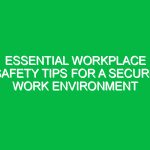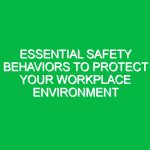Welcome Team
Good morning, everyone! Today, we’re taking a moment for a toolbox talk that dives deep into a crucial concept in our workplace: The Ripple Effect of Safety. Understanding this concept can significantly impact our daily operations, enhance our Safety culture, and ultimately protect each one of us. Let’s explore how our actions can create a ripple effect that extends beyond our immediate Environment, affecting our colleagues, families, and community.
Understanding The Ripple Effect of Safety
So, what exactly is The Ripple Effect of Safety? Imagine throwing a stone into a calm pond. The stone’s impact creates ripples that spread outward, affecting everything in their path. In a similar way, our safety practices here at work can create ripples that influence not only our immediate surroundings but also extend to our families and the broader community.
Every choice we make regarding safety has consequences. When we prioritize safety, we not only protect ourselves but also set an example for our peers. Conversely, neglecting safety can lead to accidents that may affect others, creating a chain reaction of negative consequences.
The Importance of Safety in Daily Operations
In our line of work, safety is not just a policy; it’s a way of life. Every task we perform carries inherent risks, and understanding these risks is vital to maintaining a safe work environment. Here are some key aspects to consider:
- Awareness: Being aware of our surroundings and the potential Hazards is the first step in preventing accidents.
- Communication: Open dialogue about safety concerns fosters a culture of safety where everyone feels responsible for their own well-being and that of others.
- Training: Regular safety Training ensures that we are prepared to handle emergencies and understand the Best Practices for our specific tasks.
Real-Life Examples of The Ripple Effect
Let’s illustrate The Ripple Effect of Safety with a couple of scenarios that may resonate with you:
- Scenario One: Imagine a team member who rushes through a safety check because they feel pressured to meet a deadline. This decision leads to a faulty piece of equipment being used, resulting in an injury. This injury not only affects the injured worker but also impacts their family, coworkers, and the project timeline.
- Scenario Two: Now, consider a different approach. A worker takes the time to perform a thorough safety check, identifying issues before they can cause harm. This not only protects the worker but also fosters a culture of safety, encouraging others to follow suit. The positive ripple effect enhances team morale and productivity.
Key Components of The Ripple Effect of Safety
To fully leverage The Ripple Effect of Safety, we must focus on several key components:
- Personal Responsibility: Each of us has a role in maintaining safety. By taking responsibility for our actions, we contribute to a safer work environment.
- Peer Influence: We influence each other, whether positively or negatively. By promoting Safe Practices, we can create a culture where safety is a shared priority.
- Feedback Mechanisms: Providing feedback about safety practices helps to identify areas of improvement. Constructive criticism can lead to enhanced safety protocols.
Best Practices for Enhancing Safety Culture
Here are some actionable guidelines to help us elevate our safety culture:
- Conduct Regular Safety Audits: Regularly reviewing our safety Procedures helps identify potential Hazards and ensures compliance with Regulations.
- Foster Open Communication: Encourage team members to voice safety concerns without fear of repercussion. This open dialogue can lead to crucial insights.
- Celebrate Safety Wins: Recognize and celebrate Safe Practices among team members. This not only motivates individuals but also reinforces the importance of safety.
Addressing Hazards and Risks
Understanding the potential hazards we face is crucial to minimizing risks. Here are some common risks we encounter and how to address them:
- Slip and Trip Hazards: Always keep work areas clean and free from obstructions. If you see something hazardous, report it immediately.
- Equipment Safety: Ensure that all equipment is properly maintained and inspected before use. Never use faulty equipment, and always follow lockout/tagout procedures.
- PPE Compliance: Personal protective equipment (PPE) is essential. Always wear the required PPE for your tasks, and ensure it is in good condition.
Regulations and Standards
Compliance with safety regulations is not just a legal obligation; it’s a moral commitment to ourselves and our colleagues. Familiarize yourself with the regulations that govern our industry, including:
- Occupational Safety and Health Administration (OSHA) standards
- Company-specific safety policies
- Environmental Protection Agency (EPA) guidelines
Understanding these regulations helps us to maintain not only compliance but also a safe working environment. Non-compliance can lead to severe consequences, both for individuals and our organization.
Creating a Culture of Safety
To truly harness The Ripple Effect of Safety, we must create a culture where safety is valued and prioritized. Here are some strategies to foster this culture:
- Empower Employees: Encourage employees to take ownership of their safety and that of their peers. When individuals feel empowered, they are more likely to adhere to safety protocols.
- Incorporate Safety into Daily Routines: Make safety a part of every task. Encourage team members to think about safety as they plan and execute their work.
- Lead by Example: Leadership should model safe behavior. When employees see their leaders prioritizing safety, they are more likely to follow suit.
Engaging in Open Dialogue
Now, I’d like to open the floor for discussion. Here are a few questions to prompt our conversation:
- What safety practices do you think have the most positive ripple Effects in our work environment?
- Can you share a time when you witnessed the ripple effect of a safety action, either positively or negatively?
- What suggestions do you have for improving our safety culture?
Conclusion
In conclusion, The Ripple Effect of Safety is a powerful concept that emphasizes the interconnectedness of our actions in the workplace. By prioritizing safety, we not only protect ourselves but also contribute to a positive and productive work environment. Remember, every small action can create significant ripples. Thank you all for your attention and commitment to maintaining a safe workplace. Let’s continue to support each other and prioritize safety in everything we do!


